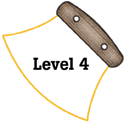
Alaska Science
Key Element D5
 |
Alaska Science |
|
Performance Standard Level 4, Ages 15–18
|
|
|
|
Sample Assessment Ideas
|
Standards Cross-References
|
||
|
National Science Education Standards Hazards and the potential for accidents exist. Regardless of the environment, the possibility of injury, illness, disability, or death may be present. Humans have a variety of mechanisms—sensory, motor, emotional, social, and technological—that can reduce and modify hazards. (Page 197) Materials from human societies affect both physical and chemical cycles of the Earth. (Page 198) Many factors influence environmental quality. Factors that students might investigate include population growth, resource use, population distribution, over-consumption, the capacity of technology to solve problems, poverty, the role of economic, political, and religious views, and different ways humans view the Earth. (Page 198) Human activities can enhance potential for hazards. Acquisition of resources, urban growth, and waste disposal can accelerate rates of natural change. (Page 199) Natural and human-induced hazards present the need for humans to assess potential danger and risk. Many changes in the environment designed by humans bring benefits to society, as well as cause risks. Students should understand the costs and trade-offs of various hazards—ranging from those with minor risk to a few people to major catastrophes with major risk to many people. The scale of events and accuracy with which scientists and engineers can (and cannot) predict events are important considerations. (Page 199) Understanding basic concepts and principles of science and technology should precede active debate about the economics, policies, politics, and ethics of various science and technology related challenges. However, understanding science alone will not resolve local, national or global challenges. (Page 199) Progress in science and technology can be affected by social issues and challenges. Funding priorities for specific health problems serve as examples of ways that social issues influence science and technology. (Page 199) Individuals and society must decide on proposals involving new research and the introduction of new technologies into society. Decisions involve assessment of alternatives, risks, costs, and benefits and consideration of who benefits and who suffers, who pays and gains, and what the risks are and who bears them. Students should understand the appropriateness and value of basic questions: “What can happen?” “What are the odds?” and “How do scientists and engineers know what will happen?” (Page 199) Humans have a major effect on other species. For example, the influence of humans on other organisms occurs through land use which decreases space available to other species, and pollution, which changes the chemical composition of air, soil, and water. (Page 199) |
Benchmarks In deciding on proposals to introduce new technologies or to curtail existing ones, some key questions arise concerning alternatives, risks, costs, and benefits. What alternative ways are there to achieve the same ends, and how do the alternatives compare to the plan being put forward? Who benefits and who suffers? What are the financial and social costs, do they change over time, and who bears them? What are the risks associated with using (or not using) the new technology, how serious are they, and who is in jeopardy? What human, material, and energy resources will be needed to build, install, operate, maintain, and replace the new technology, and where will they come from? How will the new technology and its waste products be disposed of and at what costs? (Page 57) The human species has a major impact on other species in many ways: reducing the amount of the Earth’s surface available to those other species; interfering with their food sources, changing the temperature and chemical composition of their habitats; introducing foreign species into their ecosystems, and altering organisms directly through selective breeding and genetic engineering. (Page 57) Humans inventiveness has brought new risks as well as improvements to human existence. (Page 57) |
|
Table of Contents | Return to Alaska Native Knowledge Network